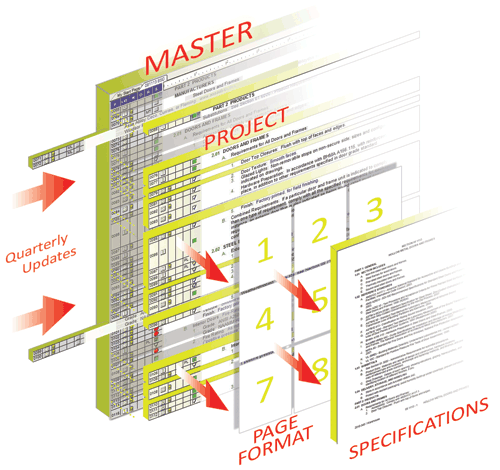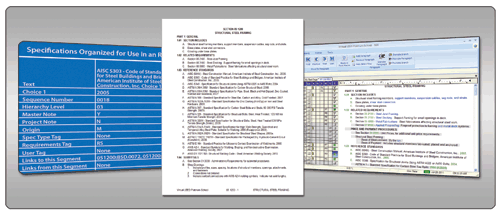BIM Interoperability and Relational Databases
Creating Specifications with RDBMS
Traditional construction specifications in word processing are organized into individual flat files labeled "sections" that are numbered sequentially. This means that data must be duplicated from section to section, increasing the likelihood of errors. It also means that relationships between sections cannot be readily established and maintained. Specifications for a project are therefore typically organized as a collection of flat files in a folder, with no other actual or virtual relationship. Commercial master guide specifications delivered as flat word processing files require periodic replacement of whole sections, rather than incremental updating of individual text data records, greatly complicating the merging of updates with text that has been edited. Because all text is part of a flat record, instead of individual paragraph records in a relational database, there are no opportunities for linking text intelligently. The flat file structure also means that functions such as data formatting and administrative reports require special "markers" to be embedded in the text, for inefficient sequential processing. In short, traditional specification production using word processing is considered obsolete by many specification writing professionals.
 |
Concept diagram of specifications creation and formatting from a relational database to output. Image courtesy of Building Systems Design, Inc. |
A typical office master specification may contain as many as 600 standardized "guide" specification sections, so managing and coordinating that many individual flat files can be a real challenge. The advantages of a relational database program over one that is based on word processing are significant. The text of each paragraph is one field in a record that can include other information, such as the text hierarchy and connections to explanatory notes that are stored in other tables. The text records can also include links to any other text record in the database, allowing related information to be activated, highlighted or suppressed. Preparing specifications in a relational database system also has the distinct advantage of organizing all the specification data into a single output file, allowing close coordination of the many sections and the individual paragraphs within those sections. In addition, the single project file can be formatted for page and text appearance in one location and can be expanded or collapsed to provide outline, short form and full construction specs without the need to start over at each phase of a project.
 |
Specifications preparation using a relational database. Data in a table is shown with options on the computer screen and generates a consistent printed result for a given project. Image courtesy of Building Systems Design, Inc. |
There are other benefits of creating specifications using a relational database management system:
- Intelligent text linkage within and between sections is possible, multiplying productivity and improving coordination. Related sections can be highlighted or selected by choices made within a particular section, while related text within a section can be activated, highlighted or excluded.
- Modification of key terms, units of measure, publication dates, etc. can be made globally across the entire project.
- It's possible to edit a master guide spec by selecting what is to be printed, rather than by deleting what isn't needed, so the master text is always available for future projects, regardless of customization. Choosing what to include in a specific project instead of deleting unneeded text preserves the master for future use. Text added by the user can also be preserved by copying to a master project.
- Related information, such as context-sensitive master notes and project notes, can appear in a separate window, avoiding confusion with the specification text. Related information can be exposed or concealed at will, depending on the need, and the windows can typically be resized and moved for convenience.
- Tagging of text in another record field allows automated report generation without the need to open multiple files and search for information sequentially. Hence automatic generation of table of contents, manufacturers listed in the project, submittals log, etc. are all readily possible.
- Page formats for the entire project are established once and carried through all sections automatically for such things as section style & numbering, page layout, fonts, headers and footers, etc.
- It's also possible to keep all project data in a separate file from the master data, so it's impossible to corrupt the master data file. Updates to the master therefore do not interfere with the project data. In addition, obsolete master data need not be deleted or replaced, merely marked, allowing the spec writer to choose whether to update a particular project or not.
Using the RDBMS approach, it's possible for a specification system to produce documentation for all types of projects and for all phases of a project–from programming all the way through construction administration. In practice, many architects, engineers and specification writers report being able to reduce their specification production time, speed up editing tasks, and update specs automatically and painlessly without disruption (see case studies in this article). Further, they are able to improve coordination of the specifications, reduce errors and omissions, and transition seamlessly from schematic design to design development to full construction specs, all using the same database. Success has also been reported in accessing automated data for simplifying the LEED certification application process and connecting to BIM through a full RDBMS interface.









